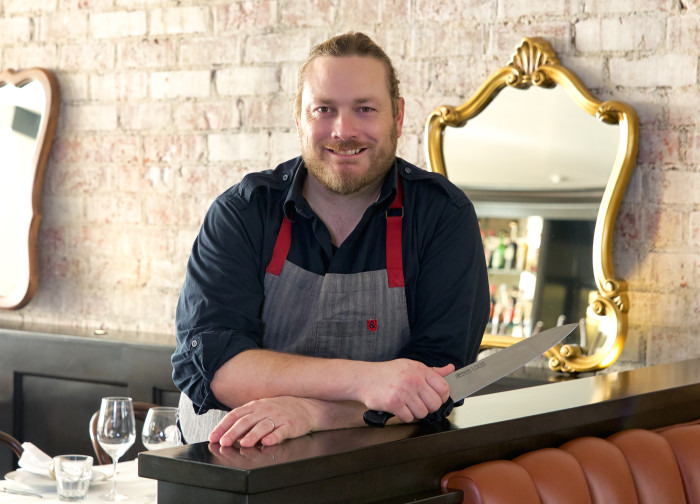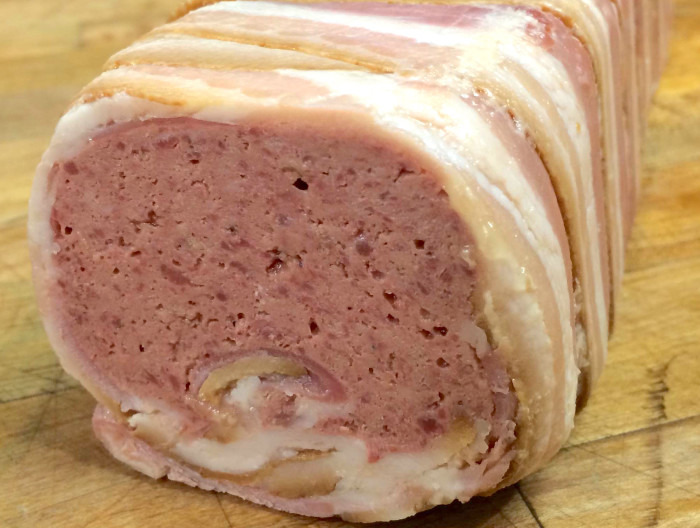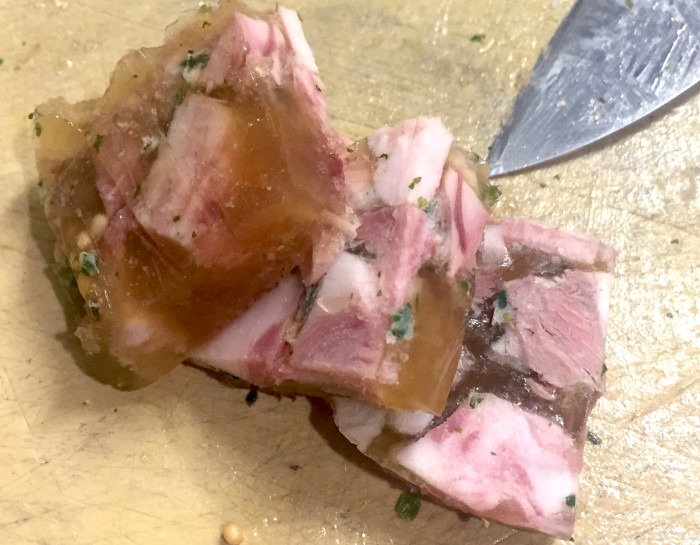Kris Morningstar's Charcuterie Board Is One Lucky Piece Of Wood
So you're in Los Angeles and craving charcuterie, eh? Well, you lucked out this time. In a health-conscious, Mexican and Korean cuisine-driven city that's not exactly known for restaurants specializing in the age-old European practice of preserving fatty meats and livers, chef Kris Morningstar is proudly sourcing pig blood. Foie gras, too — the ban's over! A Knife Fight judge and longtime veteran of L.A.'s fine dining scene, Morningstar is chef-owner of Terrine, a California brasserie churning out some of the finest pâtés, rillettes, head cheese and obscure (but delectable) preparations you've never heard of. If you go and don't order the charcuterie board — which rotates nightly and all components of which are made in-house — you are made of stone.
If you're on the fence as to whether you're down with consuming a vast array of parts from a vast array of animals, allow us to provide a gentle nudge and some whole-grain mustard.

What was the first terrine you ever made?
The first one I ever made, at Patina, was horrible. We had a bunch of extra squab livers, so I started to make a squab terrine for staff meal and didn't look up a recipe. I just kind of buzzed everything together, pushed it into a water bath and it came out spongy and airy. I didn't know what I was doing. When I worked at AOC, there was a French charcuterie chef who would not teach anybody — he refused to. He would show up at 6 a.m. and do all this stuff for the restaurant, then go home and come back for the night service. If you asked him to show you something, he'd just go, "No, no." That was one of my first big exposures to it, tasting some of the stuff he was doing. I think because I failed so badly at my first try, it pushed me to think, "I don't know how to do this. I need to learn how to do this."
Terrine is a great name for a restaurant that sells 40 stacked and loaded charcuterie boards a night. Is that the component that you identify with most?
I think it represents a way I like to cook, a little more Old Country-style, a little more rustic, working with my hands. I didn't grow up eating pâté and liverwurst. I just wasn't exposed to it until I was much older. I don't think I was even out of college before [I experienced it]. Even in culinary school, we had very limited exposure to charcuterie and were taught by a bunch of people who didn't know how to do it properly.
You need a master for that.
Yeah, everyone got out of school and was like, "This charcuterie thing isn't all that great," so I started gearing towards things that people weren't doing. Granted, now everyone's doing charcuterie, but seven or eight years ago I started making galantines because no one was making galantines. As a chef I started tinkering and doing everything I never knew how to do, if for no other reason than to educate myself. Along the way it became something I loved to do.
What kind of prep space is dedicated to in-house charcuterie at Terrine?
We have a butcher who has a five-foot board he's on almost all day, breaking down pigs or working the grinder, making sausage. It's about a five- to six-foot working space, and it's easy to spread further if there's room, but it's a busy kitchen. From there we have our storage space: two to three full shelves in the walk-in dedicated to finished charcuterie, cooked pâtés and hanging stuff.
I see you're smoking brisket, too.
We have a smoked brisket hash on our brunch menu, and we serve a piece of brisket on our hot charcuterie board as well.
That's a nice touch.
We try to do a lot of fun stuff. We do something similar to a cotechino sausage: duck meat, pork skin, pork fat, season it with breakfast-sausage seasonings, then take a one-and-a-half-ounce piece of foie gras and wrap it around the cotechino, then wrap all that in caul fat. We call it the Canard Royale.
That's too good to be served country-style [with lentils and potatoes].
It's actually served with toasted barley risotto and finished with pickled ramps.
Did you learn to butcher professionally?
No, I'm a very self-taught chef. I remember the first time I broke down a rabbit I was showing a chef who wanted to learn. So I sat there, broke it down and talked about where the joints were like I'd done it a hundred times. He was like, "How many times have you done that?" I was like, "First time" and walked away.
The bone structure of a rabbit is more like a baby lamb or or pig — just a rib cage and how it's set up. Every time I didn't know how to do something, I train myself. Like, it never occurred to me to actually make blood sausage. Then it took me four years to find someone who would sell me pork blood.
Purveyors are usually like, "I have all this pork blood to get rid of!"
Well, now I have it available, and sometimes it's having the right meat purveyors as well, but back in 2006 and 2007, it was hard to find.
Where have you traveled that has the best cured and/or smoked meats?
I'd say Italy. Actually, maybe Spain. Italy and Spain. I've been to Spain more than any other place just because I had family there growing up. I have family in Madrid and Majorca, and my sister eventually married a Galician. A couple of years back, I spent two weeks on the northern coast of Spain. You walk into the shops and there's meat everywhere, it's musty and earthy, and it's supposed to be. It's a culture shock because you just can't do that here.

Do you have a favorite part of a specific animal for a certain preparation?
I really like incorporating snouts into my liverwurst for many reasons. No matter how far you dig into nose-to-tail, I think that the snout still is maybe the most or one of the most...I don't want to say taboo, but I don't think people say, "Oh yeah, I'm gonna use the snout."
That is definitely an underutilized part of the pig. Do you use it for a gelatinous quality?
Our liverwurst is snout, liver and fat, pretty much equal parts, and we grind it super-smooth. The snout does give it that nice gelatinous texture and a really good mouthfeel. If nothing else, it is an underutilized part of the pig.
I noticed that charcuterie tends to stand alone on your menu. Sometimes on menus you'll see a chorizo vinaigrette or something is barded with salami or topped with crispy prosciutto, but your menu tends to keep the charcuterie to the charcuterie and the food to the food.
It's not a be-all, end-all. For example, we cure our own ham and did a dish called garbure, rich duck stock, beans, pulled duck confit, our house-cured ham, cabbage and turnips — a super-rustic country stew that you'd find in Gascony. I think it crosses, but we definitely wanted to focus on the charcuterie. We sell 40 boards a night without fail, and at this point, especially with the ban being lifted on foie gras in California, I've been told that my purveyor sells us more foie than anybody else.
The foie gras ban — what's something all that effort could have gone into instead?
Proper raising of animals. At this point, in restaurant land, especially in good restaurant land, it's normal to have properly sourced pigs, chicken, beef and whatnot. So much energy was put into banning foie, and while there are negative things associated with it, geese and ducks are not the worst treated animals at all. I think it would have benefited us more to make sure large factory-farm animals were raised better because that's negatively affecting more Americans than foie, something which is not actually detrimental to your health.
Can you believe that there are people in this world who think that bird livers and raw moldy hams hanging from a hook are gross?
I believe it because I see it— I think it's totally cultural.
What do you have to say to them?
I look at it from a satirical standpoint. Even as I was getting ready to open Terrine, I was reading through this old, old cookbook, and the menus are all kidneys, livers, trotters, headcheese, all this stuff that everyone finds so taboo now. Those were all normal menu items at restaurants around the country. With the economic boom after WWII, all of that got forgotten, and all of a sudden people are leaving behind "trash meats," eating filet mignon and chicken breast and overcooking pork for bacterial reasons. You can see this whole transition just from looking at menus from those time periods. As Americans, we used to eat all parts of the animal because our culture was European-built, and all of those countries have these long culinary histories. You go to Breton, blood sausage is normal; that is your breakfast.
Do you think we're headed back to that place?
I think so. You see it all over the place. Obviously, the nose-to-tail thing is taking off and people are utilizing it more, but it's slow. People are becoming more aware and educated, but I think that's happening more in urban centers.
What are the chances a home cook who loves cured meat would be able to pull off a simple preparation without poisoning themselves and their loved ones?
Pretty easy.
What's an example of charcuterie you can make at home?
Chicken liver is the easiest one. There's so many different ways to do it — Italian style, with pancetta, anchovies, capers and balsamic, or puree and then hit it with sherry. We make ours with truffle butter. We season them ahead of time, salt them, sauté them with brandy, shallots, garlic, thyme, reduce out the brandy, purée it with butter, put it through a chinois, and then we fold in the truffle butter. Some people make a custard out of it and bake it in a ramekin like flan. I personally like it buzzed with butter, which helps cut down the iron flavor.
My brother-in-law is a cook and musician. He makes his own bratwurst every year for their Oktoberfest party. It's really easy — I think you just have to try it and practice.
What is good music to make charcuterie to?
When I'm in my groove, it's usually metal or punk. One of my first investors was a punk-rock icon. We used to call my butcher Flavor Dane because he always had this stopwatch on a gold chain to make sure he didn't overcook the pâtés. But the funny thing is that for the past month he's been listening to classical music while doing charcuterie.
Pairs best with charcuterie: beer or wine? You can only choose one.
Wine. I think that the fruit flavors really complement the meat in the charcuterie. I think the acid and the flavors lend themselves better. Our house red is a Corbieres, which is on the lighter side. It can stand up to lamb, but it finishes clean. It's not overbearing, and I think it goes really nicely with it.

What are some things that are always on the charcuterie plate?
The truffle chicken liver. We have other chefs coming for the charcuterie, and the truffle chicken liver is something everyone goes nuts over. And there's pâté grand-mére and headcheese. We always have some form of headcheese on there.
What is your spirit salami? It's like a spirit animal, but...trussed and cured.
Soppressata: little bit of sweetness, little bit of spice and improves with age — fatty. Able to withstand a lot of pressure, with a little bit of mold and rough around the edges.
Would you rather die set in the middle of a fine French terrine or slowly air-cured overlooking the Alps?
Air-cured over the Alps. I've been to the Alps. It's nice.

